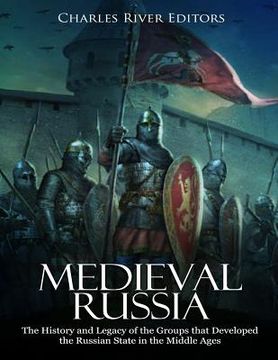Medieval Russia: The History and Legacy of the Groups that Developed the Russian State in the Middle Ages (en Inglés)
Reseña del libro "Medieval Russia: The History and Legacy of the Groups that Developed the Russian State in the Middle Ages (en Inglés)"
*Includes pictures *Includes online resources and a bibliography for further reading The formation of the state is a natural stage in the development of society. This is a very lengthy process, so any event that marks the transition to the state forms of life is very conditional. Primitive society could exist, guided by two basic principles that regulated social life: custom (tradition) and the right of the strong. Centuries-old traditions were rarely challenged, so there was no need for some special mechanisms to ensure their compliance. However, as primitive society gradually changed, the relations between the congeners became more and more diverse. The interests of an individual family did not always coincide with common interests, which destroyed the clan from the inside. There was thus a need to create new, more complex rules (like norms and laws) and to achieve their implementation. In the 8th and 9th centuries, among Eastern Slavs, the ancestral way of life was thoroughly destroyed, leading to the birth of the state. Neighboring communities could no longer be managed on the basis of old tribal customs. All this required the creation of new rules and norms. In the 9th century, the gradual strengthening of the Kniaz's power continued. This process was accelerated under the influence of external factors: in the north of the East European Plain the raids of the Varangians became a constant phenomenon, and in the south the hostility of the Slavic and Turkic tribes increased dramatically. Between 862 and 882, the majority of East Slavic tribes were united by Kiev. Thus under the rule of Kiev the Old Russian state (Kievan Rus') was established. It was an early feudal state, since it preserved the vestiges of the tribal system: the elements of military democracy. At the head of the state was the Grand Prince of Kiev, under which there was a council of the most distinguished and powerful princes. The princely vigilantes were in charge of collecting tribute, taxes, carrying out the court, etc. Special representatives of the prince (posadnik) were appointed in the cities. There had been a gradual strengthening of the power of the Kiev princes over the tribal communities of the Slavs. The Kiev princes Oleg and Vladimir united the Slavic and non-Slavic lands both by force and through various agreements. However, princely power was limited by the elements of the people's self-government (the People's Assembly, Veche, operated between the 9th and 11th centuries). In the 19th century, historians no longer interpreted the processes of the creation of the Russian state in such an immediate way. They did not reduce it to the assertion of an autocratic power capable of overcoming both the centrifugal forces within the country and the Mongol domination. The process of creating a centralized state in Eastern Russia was viewed as a definite result of the ethnic development of the people. The development of state institutions of power was associated with the processes that took place in Moscow. The content of the process itself was reduced to the struggle of various socio-political forms, and the layers of the population that stood behind them. This scheme was embodied in the work of S.M. Solovyov, who gave it a historical reasoning, revealing the inner forces of development of Russian statehood. Klyuchevsky and his followers supplemented this scheme with the study of socio-economic processes. Medieval Russia: The History and Legacy of the Groups that Developed the Russian State in the Middle Ages examines the turbulent history of the civilizations that migrated into Russia and developed cities and settlements across the vast landscape. Along with pictures of important people, places, and events, you will learn about Russia in the Middle Ages like never before.

